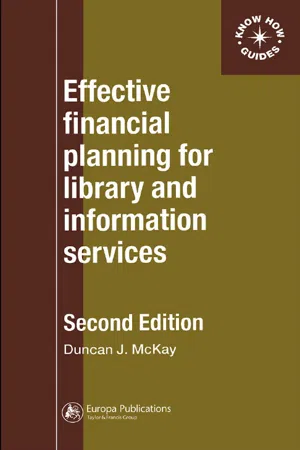Technology & Engineering
Budgeting
Budgeting is the process of creating a plan for how to spend and allocate financial resources. In the context of technology and engineering, budgeting involves forecasting and managing expenses related to projects, research, development, and infrastructure. It helps ensure that resources are used efficiently and effectively to support technological advancements and innovation.
Written by Perlego with AI-assistance
Related key terms
1 of 5
5 Key excerpts on "Budgeting"
- Frank Bannister(Author)
- 2012(Publication Date)
- Routledge(Publisher)
The scale and scope of IT Budgeting is surprisingly large and often not fully appreciated. For example, in organizations which do not sell IT as a service, the following might be a common perception of IT Budgeting:‘IT Budgeting is the process of setting short-term (usually one year) targets for all IT expenditure.’This definition is only partially complete. A better definition is:‘IT Budgeting is the process of converting the (physical) corporate and departmental IT plans into corporate and departmental financial plans which can be used as one of the methods of monitoring and controlling IT expenditure.’The rationale for this long winded definition is to stress the close relationship between the IT plan and the IT budget on the one hand and IT budget and financial control on the other. Most IT Budgeting is about expenditure, and this is made up of the costs of:• continuing support of current systems • continuing maintenance of current systems • enhancement to current systems • replacement of current systems • new systems.The development of an IT budget needs to take into account each of these. It also needs to take account of the integrated nature of IT.The above picture is complicated by a number of factors. First, some IT expenditure is infrastructural in nature. Not all IT expenditure can be mapped directly onto a particular user, department or even application. For example, a decision to replace the current coaxial cabling in the local area network with fibre optic cable may affect every system, new and old in the building. Some expenditure is enterprise-wide and, as a consequence, IT budgets have many dimensions. Figure 5.1 illustrates this principle.Figure 5.1Even Figure 5.1 does not represent the full picture. IT expenditure may be analysed by:• expenditure heading (e.g. staff costs, insurance, licences, etc.) • type (i.e. hardware, software, communications, etc.) • department • time • scenario (budget, actual, forecast) • source (i.e. internal costs, external costs, etc.).- eBook - PDF
- Jack R. Meredith, Scott M. Shafer, Samuel J. Mantel, Jr., Margaret M. Sutton(Authors)
- 2020(Publication Date)
- Wiley(Publisher)
CHAPTER 4 111 Budgeting the Project H aving finished the planning for the technical aspects of the project, there is one more important element of planning to finish that will then result in the final go-ahead from top management to initiate the project. A budget must be developed in order to obtain the resources needed to accomplish the project’s objectives. A budget is simply a plan for allocating organizational resources to the project activities. PMBOK covers the topic of Budgeting in Chapter 7 on Cost. But the budget also serves another purpose: It ties the project to the organization’s aims and objectives through organizational policy. For example, NASA’s Mars Pathfinder-Rover mission embedded a new NASA policy—to achieve a set of limited exploration opportunities at extremely limited cost. In 1976, NASA’s two Viking-Mars Lander mis-sions cost $3 billion to develop. In 1997, however, the Pathfinder-Rover mission cost only $175 million to develop, a whopping 94 percent reduction. The difference was the change in organizational policy from a design-to-performance orientation to a design-to-cost orientation. In Chapter 3, we described the project planning process as a set of steps that began with the overall project plan and then divided and subdivided the plan’s elements into smaller and smaller pieces that could finally be sequenced, assigned, scheduled, and bud-geted. Hence, the project budget is nothing more than the project plan, based on the WBS, expressed in monetary terms. Once the budget is developed, it acts as a tool for upper management to monitor and guide the project. As we will see later in this chapter, it is a necessary managerial tool, but it is not sufficient. Appropriate data must be collected and accurately reported in a timely manner or the value of the budget to identify current financial problems or anticipate upcoming ones will be lost. - Jack R. Meredith, Scott M. Shafer, Samuel J. Mantel, Jr., Margaret M. Sutton(Authors)
- 2021(Publication Date)
- Wiley(Publisher)
117 Budgeting the Project CHAPTER 4 H aving finished the planning for the technical aspects of the project, there is one more important element of planning to finish that will then result in the final go-ahead from top management to initiate the project. A budget must be developed in order to obtain the resources needed to accomplish the project’s objectives. A budget is simply a plan for allocat- ing organizational resources to the project activities. PMBOK covers the topic of Budgeting in Chapter 7 on Cost. But the budget also serves another purpose: It ties the project to the organization’s aims and objectives through organizational policy. For example, NASA’s Mars Pathfinder-Rover mission embedded a new NASA policy—to achieve a set of limited exploration opportunities at extremely limited cost. In 1976, NASA’s two Viking-Mars Lander missions cost $3 billion to develop. In 1997, however, the Pathfinder-Rover mission cost only $175 million to develop, a whopping 94 percent reduction. The difference was the change in organizational policy from a design-to-performance orientation to a design-to-cost orientation. In Chapter 3, we described the project planning process as a set of steps that began with the overall project plan and then divided and subdivided the plan’s elements into smaller and smaller pieces that could finally be sequenced, assigned, scheduled, and budgeted. Hence, the project budget is nothing more than the project plan, based on the WBS, expressed in monetary terms. Once the budget is developed, it acts as a tool for upper management to monitor and guide the project. As we will see later in this chapter, it is a necessary managerial tool, but it is not sufficient. Appropriate data must be collected and accurately reported in a timely manner or the value of the budget to identify current financial problems or anticipate upcoming ones will be lost.- Duncan McKay, Duncan Mckay(Authors)
- 2003(Publication Date)
- Routledge(Publisher)
2. Budgeting
The Oxford English Dictionary (5) defines ‘budget’ as a noun:‘A statement of probable revenue and expenditure for the ensuing year, with financial proposals funded thereon, annually submitted by the Chancellor of the Exchequer, on behalf of the Ministry, for the approval of the House of Commons. Sometimes put for the condition of the national finances as disclosed in the ministerial statement. Hence applied to an analogous statement by the finance minister of any foreign country; also to a prospective estimate of receipts and expenditure or a financial scheme, of a public body’.A more useful definition would be: ‘…statement of allocated expenditure and/or revenue, under specific headings, for a chosen period’. In most organisations it is expected that the budget is not negotiable during the period that it covers. The simple definitions are applicable to the process of Budgeting within library and information units. McElroy (7) wrote: ‘It is as much a part of professional librarianship to fight the library’s corner in the resource allocation committee as it is to carry out a literature search”. Stoffle (8) considers that: ‘Budgeting (the justifying, allocating, raising and managing of library funds) is one of the two essential components in library management, the other being creativity’.The Supplement to the Dictionary (6) defines the verb as follows: ‘to draw up or prepare a budget’.Since Koenig (9) was writing, 21 years ago, that: ‘Your budget…is the…central planning document…’, the overall Budgeting process has become more complex. In most library and information units the Budgeting process has expanded and now includes all the elements of strategic planning. The process has also evolved from the simple use of line-item budgets, based purely on previous experience and expenditure, to a much more formal planning process.- eBook - PDF
- Carl Warren, Christine Jonick, Jennifer Schneider, , Carl Warren, Carl Warren, Christine Jonick, Jennifer Schneider(Authors)
- 2020(Publication Date)
- Cengage Learning EMEA(Publisher)
2 Describe the basic elements of the budget process, the two major types of Budgeting, and the use of computers in Budgeting. Budgeting Systems Static Budget Flexible Budget EE 22-1 Computerized Budgeting Systems OBJ. 3 Describe the master budget for a manufacturing company. Master Budget OBJ. 4 Prepare the basic operating budgets for a manufacturing company. Operating Budgets Sales Budget Production Budget EE 22-2 Direct Materials Purchases Budget EE 22-3 Direct Labor Cost Budget EE 22-4 Factory Overhead Cost Budget Cost of Goods Sold Budget EE 22-5 Selling and Administrative Expenses Budget Budgeted Income Statement OBJ. 5 Prepare financial budgets for a manufacturing company. Financial Budgets Cash Budget EE 22-6 Capital Expenditures Budget Budgeted Balance Sheet Link to Hendrick Motorsports Hendrick Motorsports holds a record of 11 NASCAR Sprint Cup Series Championships won by the following drivers: 6 by Jimmie Johnson, 4 by Jeff Gordon, and 1 by Terry Labonte. Planning, Directing, and Controlling E X H I B I T 1 Copyright 2021 Cengage Learning. All Rights Reserved. May not be copied, scanned, or duplicated, in whole or in part. Due to electronic rights, some third party content may be suppressed from the eBook and/or eChapter(s). Editorial review has deemed that any suppressed content does not materially affect the overall learning experience. Cengage Learning reserves the right to remove additional content at any time if subsequent rights restrictions require it. Chapter 22 Budgeting 1075 Planning involves setting goals to guide decisions and help motivate employees. The planning process often identifies where operations can be improved. Directing involves decisions and actions to achieve budgeted goals. A budgetary unit of a company is called a responsibility center. Each responsibility center is led by a manager who has the authority and responsibility for achieving the center’s bud- geted goals.
Index pages curate the most relevant extracts from our library of academic textbooks. They’ve been created using an in-house natural language model (NLM), each adding context and meaning to key research topics.




